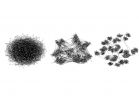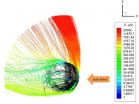(Press-News.org) DURHAM, N.C. -- Researchers have analyzed size data for rodents worldwide to distinguish the truly massive mice and giant gerbils from the regular-sized rodents. They found that the furry animals with chisel-like teeth are 17 times more likely to evolve to nightmarish proportions on islands than elsewhere.
The results are in keeping with an idea called the 'island rule,' which previous studies claimed didn't apply to rodents. The study appears online in the journal Proceedings of the Royal Society B.
Duke University biologists Paul Durst and Louise Roth analyzed data from more than 1,000 rodent populations representing more than 60 species across the globe. The dataset included mice, rats, squirrels, hamsters and porcupines, ranging in size from the tiny 0.2-ounce harvest mouse to the nearly 50-pound North American beaver.
There may be nothing remarkable about a 100-pound capybara -- a South American rodent the size of a St. Bernard -- if that's the norm for that species, the researchers say. The question gnawing at Durst and Roth was identifying the rodents that, over time, have become exceptionally large or small for their kind.
In other words, which parts of the world are home to the hugest hamsters, or the smallest squirrels?
The answer was islands. More than half of the rodent populations on the 182 islands they looked at weighed in among the top or bottom 2.5 percent for size for their species.
Take Coues' rice rat, for example, which researchers believe got to the island of Cozumel from nearby Mexico and Guatemala. Some island populations have grown to more than twice the size of their mainland counterparts.
'Deer mice, too, are nearly twice as big on the Gulf Islands off the coast of Vancouver than on the North American mainland,' said Durst, who is now a postdoctoral fellow at the University of North Carolina at Chapel Hill.
Scientists don't know how long ago most rodents arrived on the islands from the mainland territories where they originated, or how long each took to reach peculiar proportions.
For the most part, the researchers discovered that the extreme cases were unusually large, rather than unusually tiny.
The few dwarfs in their dataset are found on hot, dry islands that are particularly brown or barren rather than lush and green. An Asian tree squirrel called Finlayson's squirrel, for example, has shrunk by half since arriving on the Thai island of Ko Lan.
'They don't have the resources they need to get big,' Durst said.
Size changes in island animals are well-known to science. In 1964, biologist J. Bristol Foster surveyed size trends in island and mainland animals and suggested that large animals usually get smaller on islands, and small animals usually get bigger, a generalization that biologists later dubbed 'the island rule.'
Data collected for animals like elephants and deer in the decades that followed proved largely consistent with the island rule, but until recently the question of whether rodents followed the same size trends was far from clear cut.
INFORMATION:
This work was supported by grants from the National Science Foundation (EF-0905606, 1311597).
Citation:'Mainland Size Variation Informs Predictive Models of Exceptional Insular Body Size Change in Rodents,' P. Durst and V. L. Roth. Proceedings of the Royal Society B, June 17, 2015. http://dx.doi.org/10.1098/rspb.2015.0239
PHILADELPHIA -- House calls, a long-running option dating back to the early days of medicine, can be used in a new way to improve geriatric care and lower costs, says a report issued last week from the Centers for Medicare and Medicaid Services (CMS).
Using first year results from Penn Medicine's Truman G. Schnabel In-Home Primary Care Program and its partners in the Mid Atlantic Consortium, Medstar Washington Hospital Center and Virginia Commonwealth University (VCU) along with the 16 other IAH practices nationwide, CMS announced last week more than $25 million was saved ...
For severely obese people, bariatric surgery may have a benefit besides dramatic weight loss: it can also substantially reduce urinary incontinence.
A new investigation led by UC San Francisco is the first to examine the longer-term effects of the surgical procedure on incontinence three years after bariatric surgery. The study appears online June 22 in JAMA Internal Medicine.
'Our findings showing another important long-term benefit to bariatric surgery might help to motivate people who are severely overweight,' said first author Leslee L. Subak, M.D., a UCSF professor ...
Somehow, colorful tropical scarlet macaws from tropical Mesoamerica -- the term anthropologists use to refer to Mexico and parts of northern Central America -- ended up hundreds of miles north in the desert ruins of an ancient civilization in what is now New Mexico.
Early scientists began excavating the large Pueblo settlements in Chaco Canyon in northwestern New Mexico and found the birds' remains in the late 1890s, but only recent radiocarbon dating of the physical evidence has pushed back the time period of sophisticated Pueblo culture by at least 150 years, according ...
Social networks affect every aspect of our lives, from the jobs we get and the technologies we adopt to the partners we choose and the healthiness of our lifestyles. But where do they come from?
In a new study, the University of Pennsylvania's Damon Centola shows how social networks form and what that means for the ideas that will spread across them.
Counterintuitively, he finds that breaking down group boundaries to increase the spread of knowledge across populations may ultimately result in less-effective knowledge sharing. Instead, his research shows that best ...
CORVALLIS, Ore. - A study at Oregon State University indicates that both a high-fat and a high-sugar diet, compared to a normal diet, cause changes in gut bacteria that appear related to a significant loss of "cognitive flexibility," or the power to adapt and adjust to changing situations.
This effect was most serious on the high-sugar diet, which also showed an impairment of early learning for both long-term and short-term memory.
The findings are consistent with some other studies about the impact of fat and sugar on cognitive function and behavior, and suggest that ...
If planets had personalities, Mars would be a rock star according to recent preliminary results from NASA's MAVEN spacecraft. Mars sports a "Mohawk" of escaping atmospheric particles at its poles, "wears" a layer of metal particles high in its atmosphere, and lights up with aurora after being smacked by solar storms. MAVEN is also mapping out the escaping atmospheric particles. The early results are being discussed at a MAVEN-sponsored "new media" workshop held in Berkeley, California, on June 19-21.
The Mars Atmosphere and Volatile Evolution (MAVEN) spacecraft was launched ...
COLUMBIA, Mo. - In 1964, renowned biologists Peter Raven and Paul Erhlich published a landmark study that introduced the concept of co-evolution. Using butterflies and plants as primary examples, the team determined that two species can reciprocally drive each other's evolution and development. Now, an international team of researchers led by the University of Missouri and Stockholm University has used cutting-edge genomics to analyze the co-evolution theory and identified the mechanisms responsible for this phenomenon. Scientists believe that understanding how co-evolution ...
Our brains track moving objects by applying one of the algorithms your phone's GPS uses, according to researchers at the University of Rochester. This same algorithm also explains why we are fooled by several motion-related optical illusions, including the sudden "break" of baseball's well known "curveball illusion."
The new open-access study published in PNAS shows that our brains apply an algorithm, known as a Kalman filter, when tracking an object's position. This algorithm helps the brain process less than perfect visual signals, such as when objects move to the ...
Amid reports that rank today's teens as the most stressed generation in the country, a new study offers hope for helping them effectively manage stress and build long-term resiliency. A pilot study, published in the spring issue of the journal Advances in Mind-Body Medicine, describes how a stress-reduction/resiliency-building curriculum developed by the Benson-Henry Institute (BHI) at Massachusetts General Hospital (MGH) helped a group of Boston-area high school students significantly reduce their anxiety levels, increase productivity and effectively manage stress over ...
PROVIDENCE, R.I. [Brown University] -- Fish are power eaters. In many species, large muscles running along their backs and bellies provide bursts of speed for chasing down prey. Then, at the very instant they close in, they vacuum victims into their suddenly gaping mouths with overwhelming suction. It turns out that these power surges are no anatomical coincidence. A new study shows that largemouth bass get their slurping power from the very same muscles that provide their swimming power.
In the Proceedings of the National Academy of Sciences, Brown University researchers ...




